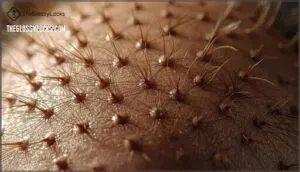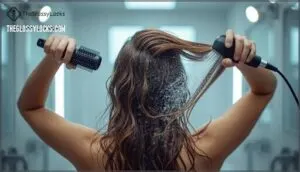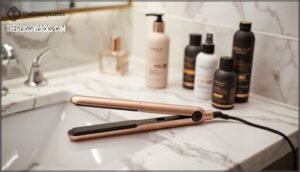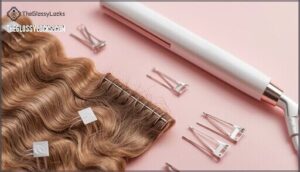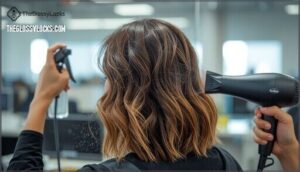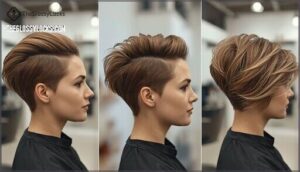This site is supported by our readers. We may earn a commission, at no cost to you, if you purchase through links.
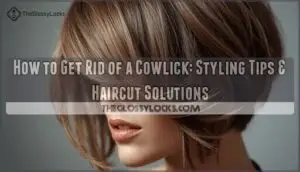
Over 80% of people have at least one cowlick, with the crown being the most common battleground, and while you can’t erase the growth pattern itself, you can absolutely outsmart it.
The right combination of strategic cutting, targeted blow-drying techniques, and product choices transforms that frustrating swirl from your styling nemesis into a manageable part of your routine.
Table Of Contents
Key Takeaways
- Cowlicks are permanent growth patterns locked in by genetics before birth—you can’t eliminate them, but you can redirect them with blow-drying against the natural swirl while hair is wet and using strategic cuts that add weight where needed.
- The most effective daily fix involves wet hair, a concentrator nozzle, firm tension with a round brush pulling opposite the growth direction, and finishing with cool air to lock the shape in place for hours.
- Haircut length matters more than you’d think—3 to 4 inches provides enough weight to flatten most cowlicks, while cuts under 2 inches lack the mass to stay down, and crown swirls typically need 5 to 7 inches for real control.
- Stop fighting your cowlick and start using it—styles like quiffs, textured shags, and side-swept cuts turn that natural lift into intentional volume and movement that looks purposeful instead of messy.
What Causes a Cowlick?
A cowlick isn’t just a styling challenge, it’s actually written into your DNA from the start. The way your hair decides to grow has everything to do with how your follicles were positioned before you were even born, and that pattern sticks with you for life.
Your cowlick is hardwired into your DNA before birth, locked in by follicle positioning that never changes
Understanding what creates these stubborn sections can help you work with them instead of fighting a battle you can’t win.
Hair Growth Patterns and Genetics
Your cowlick’s stubborn behavior comes down to genetics and embryonic development. Follicle orientation gets locked in during fetal life, permanently fixing how your hair emerges from your scalp. Understanding cowlicks means recognizing these growth patterns can’t be undone, though managing cowlicks effectively is possible with the right approach. A cowlick is simply a natural hair growth pattern.
- Genetic inheritance determines follicle angles through multiple genes, with up to 80% concordance in identical twins
- Molecular mechanisms like planar cell polarity pathways control follicular alignment during hair formation
- Ethnic variability shows dramatic differences, ranging from 1.7% prevalence in Thai women to 64% in Caucasian populations
Dealing with cowlicks requires working with your natural hair growth patterns, not against them.
Common Locations of Cowlicks
Understanding where cowlicks show up helps you target your styling efforts. The crown area takes the lead, with more than 80% of people displaying a whorl pattern there that spins clockwise or counterclockwise. Your hairline and temples can also host frontal whorls and temporal cowlicks, while nape cowlicks appear less often but matter most in shorter cuts. One key factor is that hair follicle angle determines hair growth direction.
| Location | Prevalence | Styling Challenge |
|---|---|---|
| Crown (vertex) | 80%+ of people | Spiral pattern, often mistaken for thinning |
| Frontal hairline | ~7% of individuals | Affects part direction, creates lift |
| Temples/sides | Less common | Disrupts face-framing, resists direction change |
| Nape of neck | Occasional | Creates flips or ridges in short cuts |
| Double cowlicks | 4–5% of people | Complicates symmetry, typically near crown |
About 5% of people will spot double cowlicks, usually near the crown, making styling trickier but manageable with targeted techniques.
Hair Type and Texture Influences
Your hair texture plays a bigger role than location alone. Fine hair makes cowlicks stand out because lightweight strands lack the heft to stay down, while coarse hair and thick strand thickness help mask unruly hair by blending the swirl into surrounding volume.
Gray hair turns wiry and resists styling, so older clients often notice their cowlick more.
Higher hair density compresses the whorl, but thinning hair exposes the follicle angle, making styling cowlicks harder as hair type shifts with age.
Can You Permanently Get Rid of a Cowlick?
Here’s the truth: you can’t permanently eliminate a cowlick because it’s hardwired into your scalp from birth. The direction your hair grows is set by how your follicles are angled, and that’s determined by genetics.
However, there are some long-term options worth knowing about if you’re looking for more than just daily styling fixes.
Why Cowlicks Cannot Be Fully Eliminated
You can’t truly eliminate a cowlick because your hair follicle orientation is locked in before birth. The genetic origins of cowlicks mean each follicle sits at a fixed angle in your dermis, creating structural constraints that no product or styling trick can permanently change.
Even if you cut, shave, or chemically treat your hair, the roots will always grow back in the same direction. That’s a common misconception about taming cowlicks—you’re working with biology, not against it.
Long-Term Medical or Surgical Options
If you’re willing to entertain permanent changes, hair transplantation techniques like follicular unit extraction can realign stubborn follicles by repositioning individual hair grafts to match your desired growth pattern. Hairline correction surgery uses precise graft angle mapping to blend cowlicks seamlessly.
Low-level laser therapy stimulates follicular stem cells, promoting stronger regrowth over 16–26 weeks. Supportive therapies like minoxidil improve hair follicle health around problem areas, while emerging regenerative methods including platelet-rich plasma injections show promising density improvements for persistent hair growth challenges.
Best Styling Techniques for Taming Cowlicks
Taming a cowlick doesn’t require magic, just the right approach and a bit of patience. The techniques below work with your hair’s natural growth pattern instead of fighting against it, making your morning routine simpler and your results more reliable.
Here’s how to take control of those stubborn strands.
Blow Drying Against The Growth Pattern
One of the most effective hair styling techniques is blow drying your cowlick while your hair is sopping wet, steering airflow against the natural growth pattern. Use a round or paddle brush to apply firm tension in the opposite direction of how the hair wants to fall, which smooths stubborn sections considerably.
Attach a concentrator nozzle for precise airflow control and finish with the cool shot button to lock everything in place. This wet-to-dry method combined with product synergy gives you the best chance at taming that unruly hair direction.
Using Heat Styling Tools Safely
After blow drying, you can use heat styling tools like flat irons to smooth cowlick areas, but temperature guidelines and heat protection matter. Start by applying a heat protectant that shields up to 400°F to prevent damage mechanisms like keratin breakdown and moisture loss.
Then follow these safe handling practices:
- Set fine or damaged hair to 250–300°F, medium hair to 300–350°F, and coarse hair up to 400°F maximum
- Only style completely dry hair to avoid vapor burns from rapid moisture evaporation
- Work in small sections with smooth, continuous passes to prevent localized overheating
- Keep plates away from your scalp to avoid thermal injury
- Check for electrical safety certifications and unplug tools immediately after use
Securing With Clips and Pins
After heat styling, crease clips and pins lock your cowlick into place while hair cools, retraining stubborn roots temporarily. Secure clips within 2–3 cm of the cowlick root for 10–15 minutes—this extends smooth results up to 8 hours by letting keratin bonds set in your redirected pattern.
| Hair Type | Best Clip/Pin | Placement Tip | Cooling Technique |
|---|---|---|---|
| Fine | Narrow smooth-edged clips | Low tension at roots | Single-stage cooling 10 min |
| Coarse/Curly | Alligator-style grips | Strong hold without slippage | Dual-clip from both sides |
| Straight | Flat bobby pins horizontally | Compress hair shaft across swirl | Sequential top-to-base removal |
| Thick | Layered clip placement | Roots first, mids second | Two-stage anchoring 15 min |
Choose heat-resistant tools rated to 230°C, and pair clips with volumizing mousses for enhanced tension control and minimizing cowlick dominance.
Refreshing Cowlicks Throughout The Day
Your cowlick won’t wait for your big meeting—that’s why midday restyling becomes essential. Lightly mist stubborn roots with water or a hydrating spray, then use a compact blow dryer with a nozzle to redirect growth against the swirl.
Humidity effects can weaken your morning work, so keep a flexible-hold hairspray or leave-in serum handy for product touch-ups. Avoid overheating during quick fixes to protect scalp health and maintain tool efficiency while styling unruly hair throughout your day.
Recommended Haircuts and Product Choices
The right haircut can make all the difference when you’re working with a cowlick instead of fighting against it.
Your stylist has a few strategic options to help blend that stubborn section into the rest of your hair.
Let’s look at how cut and length work together to keep your cowlick under control.
Choosing The Right Haircut or Layers
The right haircut works like a strategic partner for managing stubborn growth patterns. Layered haircuts and directional cutting techniques reduce visible contrast by up to 40%, making cowlicks blend naturally with surrounding hair.
Hair styling tips for cowlicks start with smart haircut recommendations that respect your hair’s natural direction rather than fighting it.
- Layered haircuts soften harsh transitions and improve blending precision by distributing weight where you need it most
- Directional cutting follows natural growth flow, reducing visible lift by over 50% compared to standard cuts
- Short textures like crew cuts or cropped styles minimize upward projection in dense cowlick areas
- Blending layers with texturizing shears creates feathering that prevents bulk buildup at problem zones
- Modern integration through side-swept styles or undercuts hides crown cowlicks while maintaining contemporary appeal
Length Considerations for Cowlicks
Beyond selecting the right haircut, Best Length plays a major role in managing those stubborn growth patterns. Hair measuring 3 to 4 inches provides enough weight to reduce cowlick visibility, while short hair under 2 inches often lacks mass to lie flat. Crown cowlicks usually need 5 to 7 inches for easier styling, but frontal ones respond better to slightly shorter lengths combined with directional blow-drying.
| Hair Length | Cowlick Management |
|---|---|
| Under 2 inches | Lacks weight; cowlicks more visible |
| 3–4 inches | Provides sufficient mass to counteract growth direction |
| 5–7 inches | Best for crown cowlicks; allows styling flexibility |
Density and texture also influence cowlick management. Finer strands need extra length to weigh down, while thicker hair gains stability sooner. Regional variations, such as double cowlicks or nape patterns, may require precise layering for effective management.
Regular growth maintenance is essential. Trimming every 6 to 8 weeks prevents split ends, which can emphasize uneven patterns, keeping long hair manageable and the haircut balanced.
Tips for Managing and Embracing Your Cowlick
At some point, you’ll need to shift from fighting your cowlick to working with it. The truth is, these patterns aren’t flaws to hide—they’re features you can learn to style around or even highlight.
Here’s how to make peace with your cowlick and find approaches that fit your lifestyle.
Making Your Cowlick Work for Your Style
Instead of battling against your growth pattern, consider turning that cowlick into your signature feature. Some of today’s most stylish looks actually celebrate that natural lift and movement:
- Quiffs and pompadours use cowlick volume to add height and character without extra teasing
- Textured shags transform swirl patterns into intentional styling through strategic layering
- Side-swept styles follow your cowlick’s natural curve, creating dimension that looks purposeful
Embrace the swirl as individual expression, working with what makes your hair uniquely yours rather than fighting it every morning.
Consulting a Hairstylist for Advice
When styling feels like fighting a losing battle, booking time with a hairstylist for professional advice changes everything.
A skilled stylist performs scalp analysis to map your cowlick’s spiral pattern and tension points, then delivers individual recommendations based on your hair’s unique behavior.
They’ll demonstrate product application techniques, explain treatment options like keratin smoothing or texture perms, and create maintenance plans with follow-up appointments every six to eight weeks to track regrowth direction and adjust your haircut as needed.
Low-Maintenance Care and Embracing Natural Texture
Sometimes the best approach to unruly hair is letting it be. Texture acceptance is trending—over 70% of consumers now embrace natural hair patterns, including stubborn cowlicks, as part of minimalist routines.
Try these low-maintenance strategies for styling with cowlicks:
- Apply scalp health serums with tea tree or rosemary oil to strengthen roots
- Choose eco-friendly haircare like sulfate-free shampoos that reduce frizz naturally
- Air-dry instead of heat-styling to preserve your hair’s natural movement
- Use individual products matched to your porosity and texture
- Work with your cowlick’s direction rather than against it
This shift toward natural texture saves time and celebrates what makes your hair uniquely yours.
Frequently Asked Questions (FAQs)
How do you get rid of a cowlick?
You can’t fully eliminate a cowlick, but you can manage it with blow-dry techniques, strategic haircuts, and styling products that work with your natural texture instead of fighting against it.
What is the best way to get rid of angular cheilitis?
Topical antifungals like miconazole effectively treat angular cheilitis caused by fungal infections, with cure rates reaching 100%. Antibiotic treatments address bacterial causes.
Barrier creams protect healing skin from moisture. Treatment duration generally spans two weeks, though healing time may improve within days with proper therapy.
Can Hardy pull off a cowlick?
Studies show 64% of women have a cowlick, making it a common trait. Tom Hardy’s rugged appeal includes his cowlick—he styles it confidently with textured, brushed-back cuts.
Public opinion and media influence praise his look, contributing to cultural acceptance of natural hair styling and cowlick hair as masculine and simple.
How to tame a cowlick?
Wet your hair first, then blow-dry against the cowlick’s natural growth pattern using medium heat and a heat protectant.
Apply a strong-hold styling product like pomade or gel while damp, secure with clips as it cools, and refresh throughout the day for hairstyle longevity.
Will a cowlick fix itself?
No, a cowlick won’t fix itself because the growth direction is genetically determined during development. While age can affect hair density and texture, the fundamental follicle orientation remains stable, so your cowlick stays put without styling intervention or haircut adjustments.
How to hide a cowlick?
Blow-dry against the growth pattern using a round brush, and apply styling products like pomade or wax to damp hair.
Use strategic layers or textured cuts to camouflage the cowlick naturally.
What is a Cowlick?
Ever notice a stubborn hair sprig that refuses to lie flat? That’s a cowlick—sections where follicle direction creates unruly hair growth patterns.
Hair whorls at your crown or hairline cause these hair roots to grow against surrounding strands, making cowlick hair notoriously difficult to tame.
Are Cowlicks Genetic?
Yes, cowlicks are genetic. Follicle orientation and hair growth patterns are polygenic traits, determined by multiple genes during fetal development.
Over 95% of people have at least one cowlick, and inheritance patterns show they often run in families, with ethnic variations in prevalence.
Does Everyone Have a Cowlick?
Nearly everyone has at least one cowlick, making them a common feature rather than an oddity.
Prevalence rates vary by population, with some studies showing up to 64% of people have a noticeable cowlick at the hairline or crown where hair strands grow in opposing directions.
Is a Cowlick Sexy?
Attractiveness is subjective, and cowlicks don’t make or break your hair appearance. Celebrities like Anne Hathaway and Billie Eilish embrace their cowlicks, showing confidence matters more than perfect hair.
Media influence and cultural perceptions shape what’s trendy, with styling confidence often boosting appeal more than ideal haircut and styling.
Conclusion
You could spend the next decade wrestling with your cowlick every single morning, waging an exhausting war against biology itself—or you could accept that understanding how to get rid of a cowlick means working with your hair’s natural rebellion, not against it.
The difference between frustration and confidence comes down to technique: blow-drying in the opposite direction, choosing cuts that add strategic weight, and picking products that hold without stiffness. Your cowlick isn’t a flaw to fix—it’s a pattern to redirect with the right approach.
- https://www.keratin.com/hair-care/the-cowlick-hairstyle-biology-and-underlying-causes/
- https://www.reddit.com/r/HaircareScience/comments/oki6fw/removing_cowlicks/
- https://www.beautycarechoices.com/blog/that-pesky-cowlick
- https://www.bosley.com/blog/cowlick-hair-causes-styling-tips-and-professional-solutions/
- https://www.kslclinic.co.uk/can-a-hair-transplant-fix-a-cowlick/

